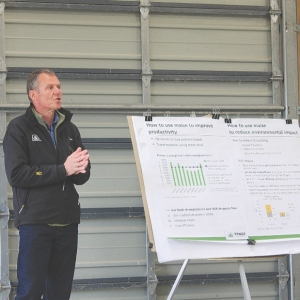Representatives of Pioneer, Ballance, HerdHomes, ANZ and Northland Regional Council addressed farmers at an on-farm meeting at Ruawai. The topic was high performance, low environmental impact.
Supplement use got a lot of mention, Pioneer forage products manager Jakob Kleinmans saying that stock fed on maize produced very little extra nitrogen due to its low crude protein content compared to other supplements or even pasture.
According to the New South Wales department of primary industries, maize contains 8.4% crude protein on average compared to 17.2% for rye and 18.4% for lucerne. This means that cows on maize produce much less nitrogen in their urine or dung while still keeping the same milk volumes, says Kleinmans. “The issue is how much urinary nitrogen do you have and how can you bring it down?”
One way to do that is to look to supplementary feeds high in carbohydrates and low in protein, Kleinmanns says. With maize having 673.86% in digestible fibre and 9.58mj/KG dry matter of metabolisable energy compared to lucerne’s 61.47% digestible fiber and 9.22mj/kg dry matter ME. “New Zealand pasture is quite high in protein, that’s why maize and pasture works so well together.”
Maize was also twice as efficient as pasture in water and nitrogen use, says Kleinmans. Its deep roots allows it to pull nitrogen and water from much deeper pasture species.
While nitrogen requirements for maize are low, Ballance regional sales representative Neil Crowson says farmers’ practice of using farm dairy effluent to feed crops can sometimes leave those crops looking for extra nitrogen, especially if that effluent is coming in sludge or solid form.
About 40% of farm dairy effluent is used to fertilise crop paddocks, says Crowson, but the form it comes in will affect how fast plants can take up the nutrients.
While liquid effluent from ponds made nutrients available to plants almost immediately, Crowson says that nitrogen in sludge and solid form takes longer to break down.
When effluent has been mixed with something like sawdust – high in carbon – it can take up to two years to break down fully, which means that only 15-25% of the nitrogen is available to the crop that needs to be fertilized, says Crowson.
With minimum soil pH requirements of 5.6-6.2, and requirement for 15 units of phosphate, four units of potassium and 20 units of magnesium, Crowson says crops often miss out on the required phosphate.
















